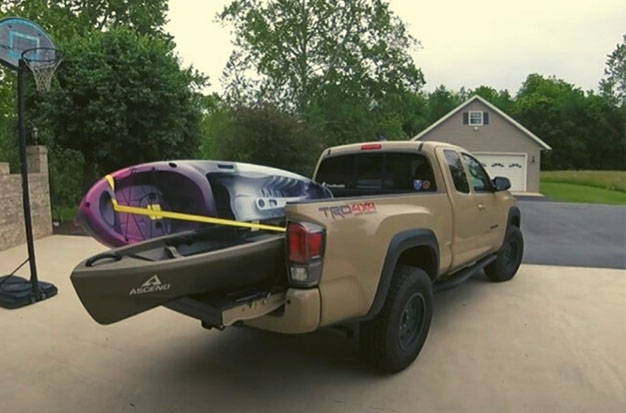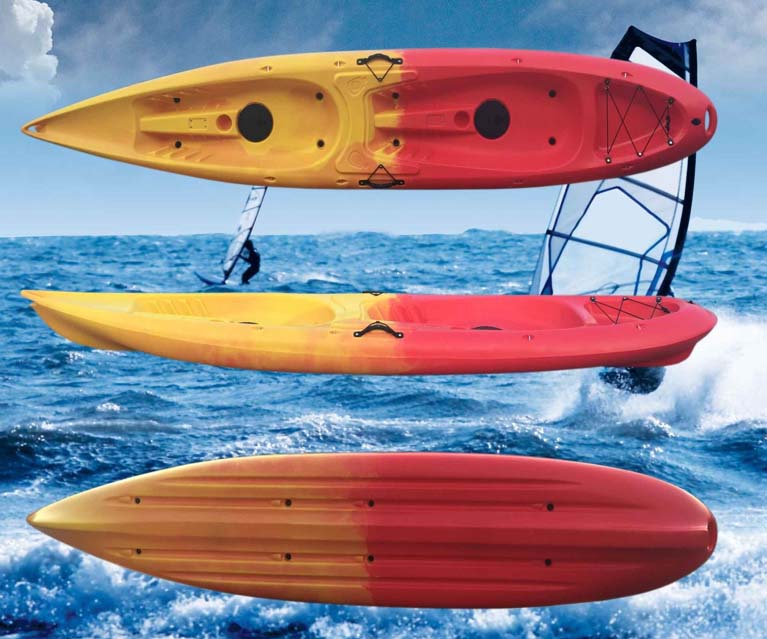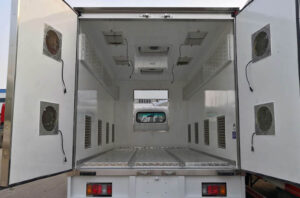
How to Transport a Kayak in a Truck?
When you need to transport a kayak, there are many ways to do this. If you have a truck with or without a camper shell, you need to know how to transport kayaks by truck.
The main problem with transporting kayaks by truck is that most kayaks will be a little longer than your truck bed. Even an eight foot card lathe is sometimes less than half length of the a longer cruising canoe there. This means that you need to properly secure the kayak to ensure that you support the weight while driving. In addition, you also need to remind other drivers that there is a long object sticking out of your truck bumper.
In this guide, we will provide some useful tips to help you safely transport kayaks on truck beds. We will also propose some restrictions that may prevent you from safely transporting kayaks on truck beds.
Ways to Transport a Kayak in a Truck
- Put the kayak on the back of the truck
This effortless method is probably the most popular way to transport kayaks by truck – and it’s not without reason. Most canoeists like it because it is a fast, simple and convenient solution, which can transport canoes without brackets on trucks. Nothing is easier than putting the kayak in the back of the truck and tying it up. You need a truck mattress, a durable rubber pad to keep your goods safe, and foam blocks to fill – but you see.
Cable lock is a good way to protect your kayak from thieves. They can cycle through each kayak handle and anchor point, making it almost impossible for others to use or take away without permission! They also act as a safety line to prevent your boat from flying on the road, so as to prevent your tether or rope from loosening or breaking.
Advantages:
- There is no need for any additional equipment or after-sales upgrades to the vehicle
- If your canoeing budget is limited, then this is an affordable canoeing transportation solution
- A convenient and direct method for shorter drives
Disadvantages:
- In order to prevent the canoe from being stolen, you need a cable lock as an additional safety measure, or use a lockable belt instead of an ordinary belt
- Kayak roof rack system
If you want to know how to carry a kayak on the truck while leaving the truck seat empty for other goods, the roof rack system is worth considering. Mounted on the top of the truck cab is a simple and non permanent method of transporting multiple kayaks without drilling or installing after-sales tie downs. The advantage of rack system is that they have various shapes and sizes and can be used in cars, trucks and SUVs. Most parts can be interchanged between vehicles, which makes them a good investment
However, remember to fix the bow and stern of the kayak, and use a set of belts to tie the kayak to the roof support to prevent the kayak from shifting or falling off. Due to strong wind, this kayak transportation mode must use bow and stern cables.
Advantages:
- Using the roof rack system of the truck can free up the base of the truck for transporting other items, such as rowing equipment and camping equipment
- You do not need to remove the roof cover
Disadvantages:
- If you drive a single cab pickup truck with only front seats, this method will not work
- Transporting something as big as a kayak may affect your fuel economy – and it’s not a good way
- Canoe truck support
If you have a pickup truck with a cab and you can’t put the kayak on the roof support, you can find a kayak support here to place the truck lathe.
You can load the kayak down on one side of the hull, place it in the center of the frame, fix it on the crossbar, and add the bow and stern lines if possible – simple.
Advantages:
- It is easier to load and unload a kayak with a lathe rack than with a roof rack
- The load-carrying capacity of truck shelves is usually higher than that of roof shelves
Disadvantages:
- Truck frames usually require semi permanent or permanent installation and may not be suitable for those who want to avoid permanent modifications
- You cannot use the top cover, which will expose your truck base to a harsh environment
- Compared with other alternative methods, this method may be a little expensive
- Truck common shelf
If you are looking for a way to transport more than one kayak, the truck common shelf is undoubtedly your best choice. It is essentially a combination of roof rack system and truck bed rack, which means you can make full use of these two worlds.
Lift the kayak onto the bracket – you may need some help – and secure it with a set of ratchets or cam belts. Best of all, you still have space left to use.
Advantages:
- This is a good solution for transporting baskets and sightseeing kayaks, which are often located on the longer side
- Combining the advantages of truck bed frame and roof frame provides higher load capacity and larger storage area – if you have multiple boats, that’s great
- It works well for long-distance travel because it frees up the truck base to haul additional gears or multiple kayaks
- Additional rail attachments can be purchased to carry ladders, bicycles, and other sports equipment. Make them a great choice for work and entertainment
Disadvantages:
- It is often noisy and will produce a lot of vibration at a higher speed; Anything over 50 miles per hour will emit a huge high pitched sound
- Assembly and installation are usually done by two people

- Underbody extender
The fifth and final method I want to discuss today is how to use a short bed truck to transport kayaks. According to experience, the truck base should support at least 70% of the kayak weight. If you can’t squeeze two-thirds of the hull because the bed is very short, you must invest in a bed expander. The truck base extender is connected to the hitch receiver, adding an additional 2 feet or more on the back of the pickup. This makes them very suitable for carrying oversized equipment, such as boats and kayaks!
Advantages:
- Easy to set up
- No modification or permanent installation is required; Use and remove the truck base extender as needed without much trouble – you only need a hook up receiver
- A cheap solution for transporting kayaks, which are not suitable for shorter card lathes
Disadvantages:
- Depending on your overhang, it may be illegal to transport kayaks in this way
- If your truck is rear ended by another car, your kayak will bear the brunt
- If you decide to try it, please check the SUNCOO pickup truck chassis hitch extender. The heavy steel frame is adjustable in width and weighs 720 pounds, including reflective tape and a set of safety signs.
How to Transport a Kayak on a Truck Bed with a Top Cover?
If a top cover is installed on the base of your truck, it should not hinder your ability to transport kayaks. You only need to know which of these methods is best for your particular truck. Most owners of Tono kayaks open the tailgate when transporting kayaks. This allows you to fix the roof cover in place and provide some weather protection while driving.
That is to say, you should be careful to avoid transporting other gears on the truck bed with the tailgate open, because the risk of losing this gear is too high. This is why some Tono cover owners use different strategies. According to the specific design of the cover, you can fold it back and put the kayak at a certain angle, so that the tailgate can be closed.
If you can do this, it means that you will retain the ability to store the kayak equipment with the kayak on the truck base. Just don’t think that your Tono cover alone is enough to support your canoe.
Some Tono canoe owners do not need to wear the canoe seat belt, but this is usually only applicable to short trips. Even if you put the kayak into your truck body from the side, we recommend that you tie the kayak tightly as if you didn’t install these covers.
How to Transport Kayaks on a Truck Bed with a Camper Shell?
For truck owners who have installed the camper shell, if the kayak is not against the side of the camper shell, it may be a little difficult to install the kayak in place from the side. This is not to say that it is impossible, but most Campervan owners will still transport their kayaks with the tailgate down.
To do this, you only need to use the same method as above, but after fixing the kayak on the bed, you should be able to flip the upper window on the camper shell. If you install a sleeping platform on the bed of the truck (it is high enough to put the kayak completely below), you can even store other equipment on the sleeping platform after closing the upper window.
This will provide you with additional covered storage space while still allowing you to keep the back seat of the truck free. However, the main problem with this method is to extend all the way to the front of your truck body to secure the front belt. Therefore, you can also explore opening the upper window and closing the tailgate. Then, you need to adjust the angle of the kayak and tie it to the corner of the truck bed at the anchor point of the D-ring.
If you want to travel long distances, you can even consider pulling down the rear window of the camper shell as much as possible, and then fixing it with a shorter cam belt. The window will not be closed all the time, but closing it as much as possible will bring more security to your whole lathe and prevent debris from flying in. If you try this method, just make sure to place a towel or other type of filler between the window and the top of the kayak.
One of the biggest disadvantages of transporting kayaks on truck beds is that this is not the best way to transport long kayaks. If you have a longer kayak, consider adding this accessory to your equipment library to help you transport the kayak more easily on the truck bed.
The truck base hitch extender allows you to support the weight of a long kayak that feels a little unstable when loaded onto the truck base. This extender is designed for square hitch receivers that slide into trucks, and there are many types of hitch receivers that are suitable for different sizes.
The best available models will allow you to adjust the width and height of the extender to match the width of the kayak and the height of the truck bed. When looking for the hitch extender, make sure it can support the full weight of the kayak.
Last Thought
The most important thing about small kayaks is that you don’t always need the best kayak roof brackets to transport them. In other words, once your kayak is more than 15 or 16 feet long, the roof rack will be the safest way of transportation. Or you can choose an inflatable kayak, which allows you to choose to transport them right on your truck bed without the need for belts or safety down. These are often the best choices for travelers or people who don’t have much extra space for truck seats. No matter what you like, you have many choices. If you keep it simple and load the kayak onto your truck bed, we hope you like the tips and strategies we provide in this guide.
FAQs of Kayak Transportation
How Long Can the Kayak Hang on the Truck?
Generally speaking, the canoe shouldn’t extend more than 3 feet forward and 4 feet back depending on your state. Nevertheless, some states do permit greater overhang, so it is advisable to check local laws beforehand.
How Do You Carry a Kayak on a Short Bed Truck?
The best option if you have a short bed truck is to add a card lathe extender. You need to securely fasten the kayak to the back of the truck because it will add extra length.
Is Kayaking Suitable for Truck Cars?
How you use the truck and kayak really makes a difference. Measure the kayak to ensure that at least 70% of it can be loaded onto the truck. If not, you must employ a different strategy.
Learn more about how to transport the following items together!
- How to Ship & Transport Frozen Breast Milk
- How to Transport a Mini Fridge In Simple Ways?
- How To Transport A Charcuterie Board – Pack & Transport
- How to Transport a Bike Without a Rack – 3 Common & Useful Ways
- How to Transport Cupcakes In the Most Simple & Economical Way
- How to Transport Drywall in Truck – Safe & Simple Ways
- How To Transport A Dirt Bike With Simple Ways?
- How to Load and Transport a Motorcycle into a Truck?
- How to Transport Chickens in a Truck – Tips and Tricks
- How Should Firearms Be Transported in a Truck?
- How Many Yards of Concrete in a Truck?



Average Rating